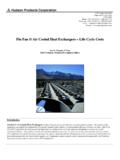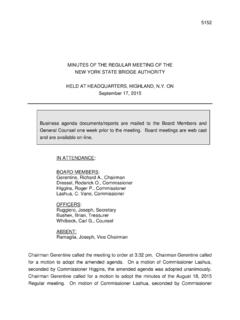Transcription of Chapter 9: Proposed Catskill Aqueduct Repair and ...
1 Chapter 9: Proposed Catskill Aqueduct Repair and rehabilitation This Chapter of the Final Draft Environmental Impact Statement (FDEIS) evaluates the Proposed Catskill Aqueduct Repair and rehabilitation ( Repair and rehabilitation ) that would occur as part of Upstate Water Supply Resiliency. It provides background on the purpose and need for the Repair and rehabilitation , describes the Proposed activities and schedule for the Repair and rehabilitation , and presents the environmental impact assessments for applicable impact categories. PURPOSE AND NEED. DEP is proposing the Repair and rehabilitation of the Catskill Aqueduct to provide water supply augmentation in support of the Rondout-West Branch Tunnel (RWBT) temporary shutdown and to extend the Catskill Aqueduct 's useful life for many years to come (see Figure ).
2 Over the years, the historical capacity of the Catskill Aqueduct has been reduced. The reduction in the capacity of the Catskill Aqueduct has occurred partly as a result of the accumulation of biofilm (a naturally occurring layer of microorganisms within a self-produced polymer) along the Aqueduct 's interior surface. Though relatively thin, the rough surface of this biofilm layer has contributed to slowing the flow of water from a historical capacity of 660 million gallons per day (mgd) to the current maximum capacity of 590 mgd. The Repair and rehabilitation seeks to restore the Aqueduct 's capacity closer to its historical maximum by removing this layer of biofilm. New air vent structures would also be installed at key points along the Aqueduct to improve water flow.
3 By removing the layer of biofilm and adding air vents to enhance the flow of water through the Aqueduct , Repair and rehabilitation would provide additional capacity to convey water ( , water supply augmentation) to facilitate the RWBT temporary shutdown. Both to potentially reduce the amount of biofilm prior to conducting biofilm removal and to limit regrowth (for the duration of the RWBT temporary shutdown), the addition of chlorine-based chemicals to the Aqueduct is Therefore, a chlorination facility is Proposed for construction at the Aqueduct headworks at Ashokan Screen Chamber in the Town of Olive, Ulster County, New York, and a dechlorination facility is Proposed prior to discharge into the Kensico Reservoir at DEP's Pleasantville Alum Plant in the Village of Pleasantville, Westchester County, New York.
4 1. Two chlorine-based chemicals ( , chlorine dioxide and sodium hypochlorite) would be used to prevent regrowth of biofilm on the Aqueduct interior. To ensure that water within the distribution system is in compliance with safe drinking water standards as regulated by the New York State Department of Health, the chemical added, and its corresponding dose, would vary depending on seasonal operating conditions. These doses would be selected to achieve the goals of the project , while limiting the potential for effects to the City's water supply ( , Kensico Reservoir) and to the Outside Community Connections that rely on the Catskill Aqueduct as a primary or secondary drinking water supply. No more than one chemical would be used at a time.
5 WFF: Upstate Water Supply Resiliency FDEIS Catskill Aqueduct Repair and rehabilitation Purpose and Need Figure : Upper Catskill Aqueduct WFF: Upstate Water Supply Resiliency FDEIS Catskill Aqueduct Repair and rehabilitation project Description In addition to improved flow of water through the Aqueduct , the Repair and rehabilitation would provide long-term benefits to the water supply system through a full inspection of the Aqueduct , Repair of leaks, Repair of valves and other mechanical equipment, and rehabilitation of existing Aqueduct segments through structural repairs. project DESCRIPTION. The following sections provide a detailed description of the Repair and rehabilitation . BACKGROUND. The Catskill Aqueduct , constructed between 1910 and 1927, extends approximately 86 miles from Ashokan Reservoir in Ulster County, New York, to Hillview Reservoir in Westchester County, New York.
6 The Catskill System provides up to 40 percent of the City's total water supply. The portion referred to as the upper Catskill Aqueduct consists of the first 74 miles, beginning at Ashokan Reservoir in Ulster County, New York, and ending at Kensico Reservoir in Westchester County, New York (see Figure ). This section of the Aqueduct also serves a number of upstate communities along its route. The section connecting Kensico Reservoir to Hillview Reservoir, referred to as the lower Catskill Aqueduct , extends approximately 12 miles along the eastern side of the Hudson River. In addition to the Catskill water supply system, the Delaware water supply system is a source of water for the City and surrounding upstate communities, providing up to 50 percent of the City's water supply.
7 Water from the Delaware System is transported by the Delaware Aqueduct , one of the City's most critical pieces of water supply infrastructure. The Delaware Aqueduct is composed of several segments, the longest of which is the RWBT. The RWBT connects Rondout Reservoir in Ulster County, New York, to West Branch Reservoir in Putnam County, New York. The RWBT is currently leaking up to 35 mgd, primarily in the area known as Roseton, in the Town of Newburgh. A second leaking section is located near the Town of Wawarsing. To address the leaks in the RWBT, an iterative planning process involving complex modeling paired with considerations for both time and cost was undertaken to determine the optimal method of Repair (see Chapter 4, Water for the Future Background and Planning ).
8 As a result of this planning process, DEP elected to construct a bypass tunnel and two associated shafts to permanently circumvent the leaking section at the Roseton crossing, and to conduct internal repairs to the section in the Town of Wawarsing. Once the bypass tunnel is connected to the existing RWBT, the leaking section would be permanently removed from service and decommissioned in place. The work undertaken to circumvent the leaking section in the Roseton crossing area is referred to as the RWBT Bypass (see Figure ). Once the bypass tunnel and shafts are completed in 2022, the RWBT would be temporarily taken offline and drained to allow connection of the bypass tunnel to the existing RWBT and to make repairs in the Town of Wawarsing.
9 DEP estimates that the maximum shutdown duration of the RWBT would be approximately 8 months. During the RWBT temporary shutdown, water from the Delaware System west of the Hudson River would be unavailable for water supply to the WFF: Upstate Water Supply Resiliency FDEIS Catskill Aqueduct Repair and rehabilitation project Description Figure : Rondout-West Branch Tunnel: Decommissioned Section and Bypass Tunnel WFF: Upstate Water Supply Resiliency FDEIS Catskill Aqueduct Repair and rehabilitation project Description City and its customers. To bridge this supply gap, DEP is proposing to Repair and rehabilitate the Catskill Aqueduct to increase the amount of water the Aqueduct can transport closer to its historical maximum, and rely more heavily on the Catskill and Croton water supply systems.
10 As noted above, the Catskill Aqueduct 's historical capacity has been reduced over time as a result of the accumulation of biofilm within the interior surface of the Aqueduct . The presence of biofilm within the Aqueduct is not unusual. Biofilm forms when microorganisms and other organic and inorganic materials adhere to surfaces in water-based environments. It grows virtually everywhere in almost any environment where there is a combination of moisture, nutrients, and a surface on which the film can accumulate. Biofilm deposits have formed on the interior wall surface of the Aqueduct as a result of naturally occurring constituents in the raw Aqueduct water, specifically iron and manganese. Though the biofilm layer is relatively thin (approximately to 1-inch thick), the deposits increase friction between the water and interior Aqueduct surface, which reduces the amount of water that can flow through the Aqueduct .
















